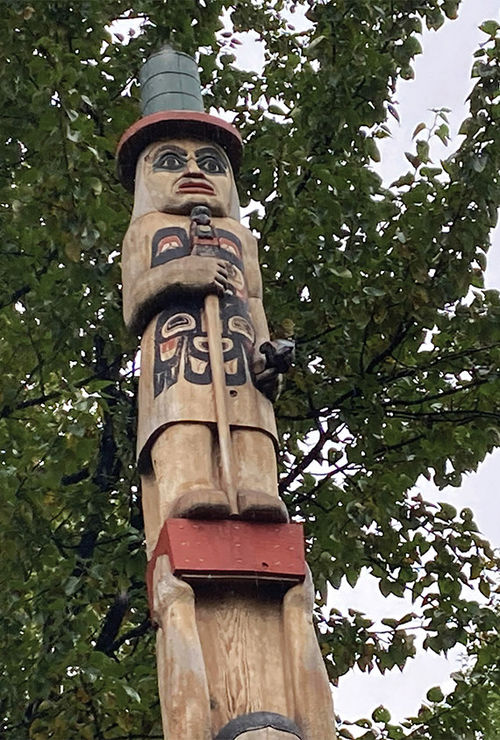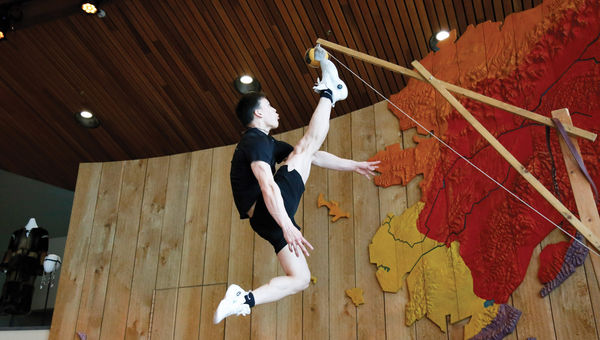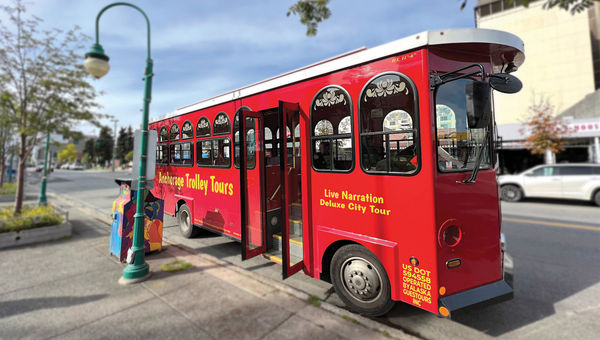For 25 years the Alaska Native Heritage Center in northeast Anchorage has been a resource for visitors to learn more about Native peoples' past, present and future.
Marking the milestone and exemplifying the state's emphasis on cultural tourism, the first phase of a $25 million capital improvement plan was completed last summer.
The warm and welcoming 20,000-square-foot facility, designed to fit in with the forested landscape, has created new ways to make Alaska Native culture more accessible.
"We really wanted to pay attention to the details and uplift our Alaska Native artist community," Emily Edenshaw, the center's CEO, told Alaska Public Media when the additions were unveiled. "I just love the outcome, it's so beautiful."

Totem poles stand throughout the Alaska Native Heritage Center. Photo Credit: Paul Szydelko
There are 229 federally recognized tribes in five major regional cultural groups across the sprawling state, depicted in a colorful map behind the stage in the Gathering Place. Suspended from the ceiling are re-creations of canoes and kayaks -- reminders of the deep maritime traditions of Alaska Natives and instrumental for transportation, trade and subsistence hunting.
A stage hosts storytelling, songs, dances and games. One prominent game often presented by Native youth are variations of high kick, in which participants attempt to kick a ball or other object suspended at various heights and land on the same foot.
The remodeled Identity Galleries explain the differences among the five regional groups. New exhibits in the refurbished Hall of Cultures have information about the Dena'ina peoples and repatriation of ancestral objects. With groundbreaking research led by the Heritage Center, the education exhibit starkly examines the harrowing and tragic forced removal of Alaska Native children to boarding schools.
Cultural tourism is "the sleeping giant in Alaska," Edenshaw told a panel at the Alaska Travel Industry Association convention in the fall. "Visitors want an authentic experience."

Exhibitions of high kick and other sports are staged at the Alaska Native Heritage Center. Photo Credit: Courtesy of Alaska Native Heritage Center
New at the Heritage Center
The facility is on 26 scenic acres around a lake named for Paul Tiulana, who grew up in King Island, provided for his family through hunting and gathering and lost a leg serving in World War II. Tiulana, who died in 1994, taught Alaska Native stories, dance, carving and skin boat building for two generations, instilling the vision of the Heritage Center.
A half-mile loop trail, which can be self-guided or taken with a tour guide, features a log cabin-style Athabascan Ceremonial House, re-created village sites, watercraft and gray whale exhibits, totem pole carving and other information about Alaska Native ways of life, survival techniques and continued living traditions.
Last year's aesthetic improvements to the Hall of Cultures, the Gathering Place, archive area and lobby include new flooring, paint and signage. Among the many artistic additions are lamps made of seal skin, seal intestine, fish skin, abalone and mother of pearl; a carpet showcasing a design of a Dene chief's necklace; illustrations; and photo murals. Custom benches represent each major cultural region.
The next phase of the project will renovate the multimedia theater to blend passive experiences, projected art and interactive virtual reality experiences. Later phases call for a Traditional Healing Garden -- an outdoor contemplative and ceremonial space with cultural monuments -- and development of a community building and subsistence kitchen.
The Alaska Native Heritage Center is a 10-minute drive from downtown Anchorage. Admission is a suggested donation of $10, rising to $30 for visits from May 11 to mid-September, and hours are from 9 a.m. to 5 p.m. Mondays to Fridays (as well as weekends after May 11). There is a free roundtrip shuttle from downtown locations. Guests should allow about three hours to take in all that the center offers.

Anchorage Trolley Tours recently introduced the Winter City Tour, a 3.5-hour, 10-stop experience that includes visits to Point Woronzof and a seafood processor offering samples of fresh salmon. Photo Credit: Courtesy of Anchorage Trolley Tours/Leslie Carter
Options for cultural exploration
There are many other places in Anchorage where visitors can explore the state's culture, robust wildlife and magnificent landscape.
- The Anchorage Museum downtown houses permanent installations such as "Living Our Cultures, Sharing Our Heritage: The First People of Alaska," an interactive gallery with more than 600 objects from the Smithsonian selected and interpreted by Alaska Natives. The "Art of the North" exhibit features sculptures, videos, photography and paintings.
- Anchorage Trolley Tours recently introduced the Winter City Tour, a heated, 3.5-hour experience with 10 stops. The tour includes the 25-foot Snow Ella snow sculpture, coffee with a pilot at Rust's Flying Service, views from Point Woronzof and visits to the Ulu knife factory and a seafood processor with samples of fresh salmon.
- The Alaska Railroad offers Aurora Winter Train passengers new excursions, including a daytrip to Borealis Basecamp with activities such as dog-sledding, snowmobiling and reindeer viewing. Add-ons include the Matanuska Glacier Winter Tour and the Southbound Arctic Circle Aurora Fly/Drive Adventure, which features a flight from Fairbanks to Coldfoot, a scenic drive along the Dalton Highway and a ride on the Alaska Railroad from Fairbanks to Anchorage.
- The Alaska Wildlife Conservation Center, about one hour north of Anchorage, has just opened the Matson Ocean Education Center, a classroom-style facility on the Cook Inlet, where visitors can view endangered beluga whales during high tides, especially in the spring and fall when they chase salmon.